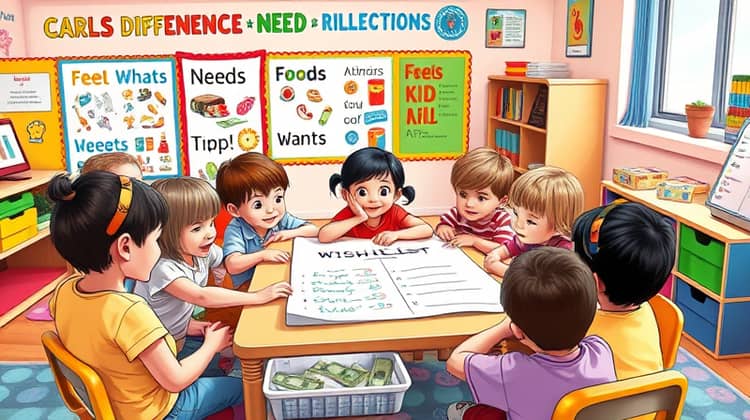Financial Literacy for Kids: 10 Essential Tips Every Parent Should Know

Teaching kids about money management is essential in today's increasingly complex financial landscape. By instilling financial literacy from an early age, parents can equip their children with the necessary skills to grow into financially responsible adults.
This article presents ten essential tips for parents to help cultivate sound financial practices in their children, setting them up for success when they manage their finances.
1. Start Early: The Power of Saving

The earlier you start teaching your children the benefits of saving, the better equipped they will be to handle their finances as they grow older. Instilling a saving habit in children helps them understand the concept of delayed gratification, which is crucial for long-term financial health.
- Introduce a piggy bank for savings.
- Encourage saving for a specific goal like a toy or game.
- Discuss the benefits of having an emergency fund.
- Teach them about saving for future experiences.
By making saving a part of your child’s routine, you lay the groundwork for smart financial decisions later in life.
2. Make It a Game: Learning Through Play

Children learn best when they're engaged and having fun. By turning financial literacy into a game, kids can absorb information in a way that feels natural and enjoyable. Interactive experiences can make the concepts of money more relatable and understandable for them.
Use board games or online platforms that simulate real-world financial situations to create a fun learning environment. These activities not only entertain but also educate.
- Play board games like Monopoly that involve money management.
- Use apps designed for kids that teach financial concepts through gameplay.
- Organize a scavenger hunt to teach the value of money in everyday purchases.
This playful approach ensures that they develop a positive attitude towards money management while creating lasting memories together.
3. Open a Bank Account: Real-World Experience

Opening a bank account for your child is an excellent way to introduce them to the world of finance. It provides a real-life experience that can help them understand how money works in a safe environment.
Give your child the responsibility of managing their savings account, which can teach them about interests, deposits, and withdrawals.
- Choose a child-friendly bank with no fees.
- Set savings goals together with your child.
- Monitor the account together to track growth.
- Encourage regular deposits from allowances or gifts.
This hands-on experience can significantly enhance their understanding of banking and is a great foundation for more complex financial principles in the future.
4. Teach the Value of Money: Needs vs. Wants

Understanding the difference between needs and wants is pivotal for children as they navigate their financial decisions. Teaching this distinction helps them prioritize their spending and allocate their resources wisely.
Engage them in discussions about what they truly need versus what they might desire at the moment.
- Discuss examples from daily life, like food versus toys.
- Have kids participate in budgeting activities for family events.
- Encourage them to make a wishlist and categorize items.
- Teach them to delay purchases until they assess their needs.
This fundamental lesson can shape their spending habits and help them make informed decisions as they grow.
5. Use Technology: Financial Apps and Tools

In the digital age, technology can be a tremendous aid in teaching kids about finance. Various apps and online tools help simplify concepts and make financial learning fun and interactive for children.
Explore age-appropriate financial literacy apps that track spending, create budgets, and teach basic banking concepts.
- Kids should try apps that simulate a banking experience.
- Use budgeting tools designed for families.
- Explore educational platforms that offer activities related to finance.
By integrating technology into learning, kids become comfortable managing digital finances, which are increasingly relevant in today's economy.
6. Give an Allowance: Practical Money Management

An allowance can serve as a practical introduction to money management for kids. It gives them a fixed amount to learn budgeting, saving, and spending in a controlled environment.
Allowances teach children about their finances and how to manage them responsibly.
- Decide on a consistent amount for the allowance.
- Encourage them to allocate for saving, spending, and charity.
- Discuss their choices regarding spending and saving after each week.
Through this framework, kids can experience financial independence while learning foundational skills.
7. Invest in Education: The Stock Market for Kids

Introducing children to the concept of investing can set them on a path to financial security. Education about the stock market and how investments work can empower kids to think of money in terms of growth and multiplication, rather than just spending.
Start by using child-friendly resources to explain the fundamentals of investing.
- Use simple explanations for stocks and shares.
- Engage them in a simulated stock market game.
- Research companies they are interested in and discuss how stocks work.
This early engagement with investing concepts can cultivate a proactive attitude toward wealth building.
8. Be a Role Model: Lead by Example

Children observe and imitate their parents' behaviors. Therefore, it's essential to demonstrate sound financial habits in your household. Your actions send strong messages about money management, whether knowingly or unknowingly.
Being a good financial role model means showing them how you budget, save, and manage debts.
- Discuss your budget with them occasionally.
- Share your savings goals and why they matter.
- Explain financial decisions you are making for the family.
- Involve them in discussions about spending choices.
By leading by example, you instill the importance of financial literacy and responsible money management in your children.
9. Encourage Giving: The Importance of Charity

Teaching kids about the value of giving back instills empathy and social responsibility. By encouraging charitable contributions, children learn the importance of helping others, which complements their financial education.
Include them in decision-making regarding where and how to give.
- Set aside a portion of their allowance for charity.
- Discuss the impact of charitable donations.
- Involve them in community service opportunities.
These experiences not only develop their understanding of money but also foster a sense of community and kindness in their hearts.
10. Keep the Conversation Going: Financial Check-Ins

Keeping an open dialogue about finances helps demystify money-related topics that children may find confusing. Regular conversations on budgeting, saving, and spending habits are essential for reinforcing learned concepts.
Establish a monthly or biweekly check-in to discuss financial matters.
- Review their savings and spending goals together.
- Discuss any financial decision they faced recently.
- Encourage questions about anything they're unsure of.
Such discussions help normalize financial topics and ensure your child feels confident addressing their money management as they continue to grow.
Conclusion

Fostering financial literacy in children is a lifelong gift that can help shape their future. By teaching them the essential skills for managing money wisely, parents can drive their success in personal finance and beyond.
These ten tips provide a structured approach for parents eager to impart financial wisdom to their kids, ultimately empowering them to thrive in their future.






